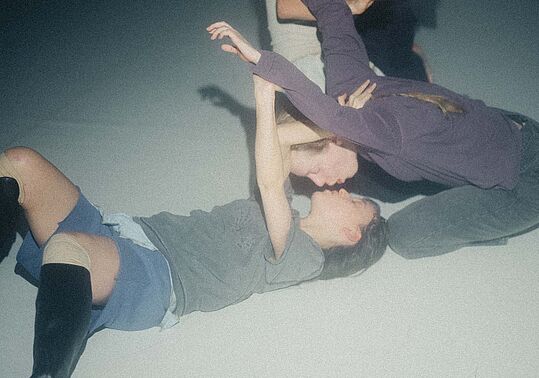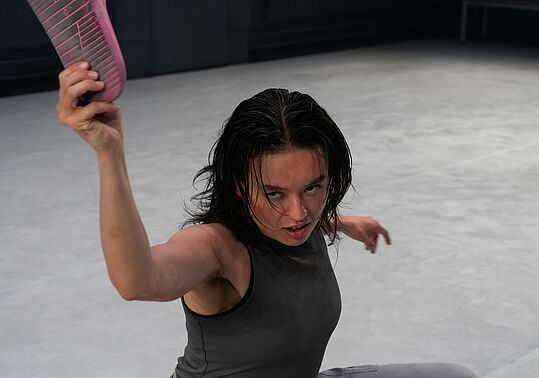Physical language
„receptacle“ is a collaboration between you, Raphael Michon and Linda Samaraweerova. How can we imagine your cooperation?
Raúl Maia: One of the main pilars of my work is the creation of performative languages that regulate a real time interaction between the performers. So the act of comunication between performers is the prime mater which is then framed to create a specific universe of experience for an audience. When I speak about language in this context, I am not refering to the aesthetic language of the performance, but an actual physical language that the performers use between them to comunicate on stage. In order to create this language I use a method based on defining new conditions for interaction between people and then we spend a lot of time interacting under those conditions. Doing so, leads to specific kinds of behaviour and habits which eventualy result in the formation of a language. So to answer your question, in this work the collaboration with the performers happens in the sense that (as artistic director ) I set the conditions for our interaction, but within those conditions the performers have almost total freedom to interact and create their own relations, each of us influencing the abstract narrative we are constructing. We could say that as the artitistic director I define the conditions for the language we are using, but the content of the dialogues between the performers is totally collaborative and happening in real-time.
The performance is composed in real time, the performers don’t know what the other performers in the room are going to do. How do you rehearse a piece like that?
Raúl Maia: For most of the performances, each performer doesn't know what the other will do, but they know which „language“ is being spoken. So not knowing what the other will do, doesen't mean that anything is possible in the sense of a completely open improvisation. As an example, if I am having a conversation in English with a complete stranger, I might not know what the person will say but we speak the same language therefore we can have a conversation and create a progressive and acumulative interaction between us. The whole interest of having the creation of a language as the base material for the construction of a performance is that we can achieve a great degree of impredictability and playfulness while at the same time also sustaining a sense of coherence and identity which is particular to any language and its associated cultural practices. Also I really value watching people interact in real-time, witnessing their reactions, their feelings, sensing their experiences in relation to something they cannot fully control and that is happening right there in front of our eyes. So the way we rehearse such works is analogous to the way we would practice perhaps the art of conversation or discussion: we exercise our knowledge of the language in relation to content proposed by each of the intervenents.
The stage design of „receptacle“ is quite different: It’s a room built inside of the Projektraum and every audience member can only see a part of the performance trough a small window. Why have you chosen this special setting?
Raúl Maia: Well, the origin of the concept for this set design lies in the fact, that originally this work was very much about working with imobility as a physical condition, or in other words, drastically reducing the scale of movement in such a way that the audience would doubt if the movement they perceived was in fact happening or simply being imagined. From that starting point, It became necessary to create a stage design that would allow for enough proximity between performers and the audience so that the very minimal movement could be perceived. This set design allows for that, the room is small and the audience is sitting all around the room and in reduced number of people. Another important aspect of the set design is that while it allows for the proximity with the performers, at the same time it also keeps each of the audience member isolated from each other through frame like structures that block the vision of the others, so as an audience you are pretty much alone in your experience of the performance. This isolation is enhanced by the fact that the sound is played out through headphones further isolating each audience member in their perception.







